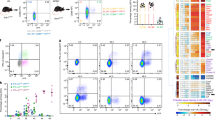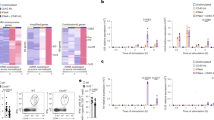Abstract
We show here that mouse interferon-α (IFN-α)–producing cells (mIPCs) are a unique subset of immature antigen-presenting cells (APCs) that secrete IFN-α upon stimulation with viruses. mIPCs have a plasmacytoid morphology, can be stained with an antibody to Ly6G and Ly6C (anti-Ly6G/C) and are Ly6C+B220+CD11cloCD4+; unlike other dendritic cell subsets, however, they do not express CD8α or CD11b. Although mIPCs undergo apoptosis in vitro, stimulation with viruses, IFN-α or CpG oligonucleotides enhanced their survival and T cell stimulatory activity. In vivo, mIPCs were the main producers of IFN-α in cytomegalovirus-infected mice, as depletion of Ly6G+/C+ cells abrogated IFN-α production. mIPCs produced interleukin 12 (IL-12) in response to viruses and CpG oligodeoxynucleotides, but not bacterial products. Although different pathogens can selectively engage various APC subsets for IL-12 production, IFN-α production is restricted to mIPCs' response to viral infection.
This is a preview of subscription content, access via your institution
Access options
Subscribe to this journal
Receive 12 print issues and online access
$209.00 per year
only $17.42 per issue
Buy this article
- Purchase on Springer Link
- Instant access to full article PDF
Prices may be subject to local taxes which are calculated during checkout








Similar content being viewed by others
References
Steinman, R. M. The dendritic cell system and its role in immunogenicity. Annu. Rev. Immunol. 9, 271–296 (1991).
Siegal, F. P. et al. The nature of the principal type 1 IFN-producing cells in human blood. Science 284, 1835–1837 (1999).
Cella, M. et al. Plasmacytoid monocytes migrate to inflamed lymph nodes and produce large amounts of type I interferon. Nature Med. 5, 919–923 (1999).
Kadowaki, N., Antonenko, S. & Liu, Y. J. Distinct CpG DNA and polyinosinic-polycytidylic acid double-stranded RNA, respectively, stimulate CD11c(−) type 2 dendritic cell precursors and CD11c(+) dendritic cells to produce type I IFN. J. Immunol. 166, 2291–2295 (2001).
Pfeffer, L. M. et al. Biological properties of recombinant α-interferons: 40th anniversary of the discovery of interferons. Cancer Res. 58, 2489–2499 (1998).
van den Broek, M., Muller, U., Huang, S., Zinkernagel, R. & Auget, M. Immune defence in mice lacking type I and/or type II interferon receptors. Immunol. Rev. 148, 5–18 (1995).
Bandyopadhyay, S., Perussia, B., Trinchieri, G., Miller, D. S. & Starr, S. E. Requirement for HLA-DR+ accessory cells in natural killing of cytomegalovirus-infected fibroblasts. J. Exp. Med. 164, 180–195 (1986).
Chehimi, J. et al. Dendritic cells and IFN-α-producing cells are two functionally distinct non-B, non-monocytic HLA-DR+ cell subsets in human peripheral blood. Immunology 68, 488–490 (1989).
Perussia, B., Fanning, V. & Trinchieri, G. A leukocyte subset bearing HLA-DR antigens is responsible for in vitro α interferon production in response to viruses. Natural Immunol. Cell Growth Regul. 4, 120–137 (1985).
Fitzgerald-Bocarsly, P. Human natural interferon-α producing cells. Pharmacol. Ther. 60, 39–62 (1993).
Starr, S. E. et al. Morphological and functional differences between HLA-DR+ peripheral blood dendritic cells and HLA-DR+ IFN-α producing cells. Adv. Exp. Med. Biol. 329, 173–178 (1993).
Cella, M., Facchetti, F., Lanzavecchia, A. & Colonna, M. Plasmacytoid dendritic cells activated by influenza virus and CD40L drive a potent TH1 polarization. Nature Immunol. 1, 305–310 (2000).
Kadowaki, N., Antonenko, S., Lau, J. Y. & Liu, Y. J. Natural interferon α/β-producing cells link innate and adaptive immunity. J. Exp. Med. 192, 219–226 (2000).
Rissoan, M. C. et al. Reciprocal control of T helper cell and dendritic cell differentiation. Science 283, 1183–1186 (1999).
Grouard, G. et al. The enigmatic plasmacytoid T cells develop into dendritic cells with interleukin (IL)-3 and CD40-ligand. J. Exp. Med. 185, 1101–1111 (1997).
Vremec, D. et al. The surface phenotype of dendritic cells purified from mouse thymus and spleen: investigation of the CD8 expression by a subpopulation of dendritic cells. J. Exp. Med. 176, 47–58 (1992).
Pulendran, B. et al. Distinct dendritic cell subsets differentially regulate the class of immune response in vivo. Proc. Natl Acad. Sci. USA 96, 1036–1041 (1999).
Maldonado-Lopez, R. et al. CD8α+ and CD8α- subclasses of dendritic cells direct the development of distinct T helper cells in vivo. J. Exp. Med. 189, 587–592 (1999).
Eloranta, M. L., Sandberg, K., Ricciardi-Castagnoli, P., Lindahl, M. & Alm, G. V. Production of interferon-α/β by murine dendritic cell lines stimulated by virus and bacteria. Scand J. Immunol. 46, 235–241 (1997).
Eloranta, M. L. & Alm, G. V. Splenic marginal metallophilic macrophages and marginal zone macrophages are the major interferon-α/β producers in mice upon intravenous challenge with herpes simplex virus. Scand J. Immunol. 49, 391–394 (1999).
Hestdal, K. et al. Characterization and regulation of RB6-8C5 antigen expression on murine bone marrow cells. J. Immunol. 147, 22–28 (1991).
Fleming, T. J., Fleming, M. L. & Malek, T. R. Selective expression of Ly-6G on myeloid lineage cells in mouse bone marrow. RB6-8C5 mAb to granulocyte–differentiation antigen (Gr-1) detects members of the Ly-6 family. J. Immunol. 151, 2399–2408 (1993).
Jutila, M. A. et al. Ly-6C is a monocyte/macrophage and endothelial cell differentiation antigen regulated by interferon-γ. Eur. J. Immunol. 18, 1819–1826 (1988).
Takahama, Y., Sharrow, S. O. & Singer, A. Expression of an unusual T cell receptor (TCR)-V β repertoire by Ly-6C+ subpopulations of CD4+ and/or CD8+ thymocytes. Evidence for a developmental relationship between Ly-6C+ thymocytes and CD4−CD8−TCR-α/β+ thymocytes. J. Immunol. 147, 2883–2891 (1991).
Sato, N. et al. Functional characterization of NK1.1+ Ly-6C+ cells. Immunol. Lett. 54, 5–9 (1996).
Rolink, A. et al. A subpopulation of B220+ cells in murine bone marrow does not express CD19 and contains natural killer cell progenitors. J. Exp. Med. 183, 187–194 (1996).
Laouar, Y. & Ezine, S. In vivo CD4+ lymph node T cells from lpr mice generate CD4-CD8-B220+TCR-βlow cells. J. Immunol. 153, 3948–3955 (1994).
Hochrein, H. et al. Differential production of IL-12, IFN-α, and IFN-γ by mouse dendritic cell subsets. J. Immunol. 166, 5448–5455 (2001).
Dalod, M. et al. IFN-α/β and IL-12 responses to viral infections: pathways regulating dendritic cell cytokine expression in vivo. (submitted, 2001).
Kadowaki, N. et al. Subsets of human dendritic cell precursors express different toll-like receptors and respond to different microbial antigens. J. Exp. Med. 194, 863–870 (2001).
Murphy, K. M., Heimberger, A. B. & Loh, D. Y. Induction by antigen of interthymic apoptosis of CD4+CD8+TCRlo thymocytes in vivo. Science 250, 1720 (1990).
Farber, D. L. T cell memory: heterogeneity and mechanisms. Clin. Immunol. 95, 173–181 (2000).
Acknowledgements
We thank C. Caux for critical reading and C. Alexandre, D. Lepot and M. Vatan for editorial assistance. Supported by NIH grant CA41268 (to C. B.) and the Cancer Research Institute (to M. D.).
Author information
Authors and Affiliations
Corresponding author
Rights and permissions
About this article
Cite this article
Asselin-Paturel, C., Boonstra, A., Dalod, M. et al. Mouse type I IFN-producing cells are immature APCs with plasmacytoid morphology. Nat Immunol 2, 1144–1150 (2001). https://doi.org/10.1038/ni736
Received:
Accepted:
Published:
Issue Date:
DOI: https://doi.org/10.1038/ni736
This article is cited by
-
Cyclical palmitoylation regulates TLR9 signalling and systemic autoimmunity in mice
Nature Communications (2024)
-
The transcription factor reservoir and chromatin landscape in activated plasmacytoid dendritic cells
BMC Genomic Data (2021)
-
Dendritic cells sub-sets are associated with inflammatory cytokine production in progressive vitiligo disease
Archives of Dermatological Research (2021)
-
The activation trajectory of plasmacytoid dendritic cells in vivo during a viral infection
Nature Immunology (2020)
-
Autoantibody-dependent amplification of inflammation in SLE
Cell Death & Disease (2020)



